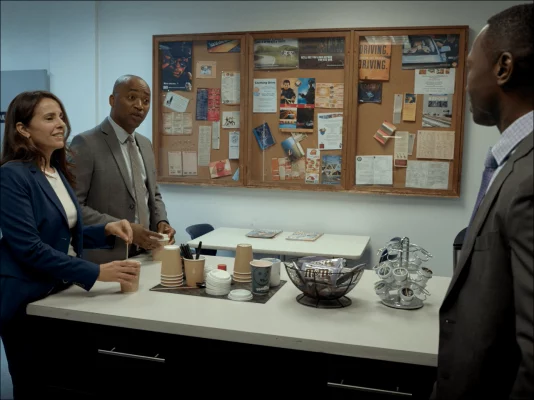
Amazon and NBCUniversal, two major players in media and entertainment, recently debuted virtual product placement (VPP) advertisements during the recently finished 2022 IAB NewFronts.
This daring move is expected to revolutionize how businesses and their target markets view and engage with brands.
What is VPP, and how many brands benefit from it?
This in-depth introduction to virtual product placement will give your marketing plan a new life.
What Is Virtual Product Placement?
You’ve witnessed it frequently before. When the camera pans in on a pair of headphones with a distinct label, you’ll see the principal actor in a movie wearing them and listening to rhythms. Or perhaps you’re watching your favorite T.V. program when you notice an actress sipping on a Coke.
A Synopsis of Product Placement History
The custom was first used in a Lumière Brothers film that featured a Lever Brothers product in the 19th century. Since then, it has expanded to include various facets of contemporary culture and media.
You have probably seen numerous instances of product placement in films, T.V. shows, and music videos. It’s a tactic that has been employed repeatedly to promote particular businesses quietly, and it works. It increases revenue, raises brand awareness, and creates an opportunity to attract new clients without being overt.
Elliott, the main character, utilized Reese’s Pieces to entice E.T. to his house in the Spielberg classic E.T. The Extra-Terrestrial, released in 1982. Within just two weeks of the release of E.T., the brief commercial promotion helped treble Reese’s sales.
Since then, product placement has benefited several companies, like FedEx (Cast Away), Lego (The Lego Movie), and Aston Martin (James Bond), in a variety of ways, including growing their fan bases, increasing revenues, and broadening their reach. Additional T.V. programs and movies with product placements are listed below:
- The Office
- Seinfeld
- Friends
- Stranger Things
- Top Gun
- The Italian Job
- Jerry Maguire
The Development of Online Product Placement
The industry of product placement is enormous. Global spending on product placements increased by almost 14% in 2021 compared to 2020, totaling a staggering $23 billion.
And in the upcoming years, it’s anticipated to grow much more. However, this “conventional” method of product advertising has started to feel a bit old as customer expectations and technology continue to change.
With streaming services, viewers may have a better viewing experience. They are no longer required to watch predetermined programs while being bothered by intrusive traditional commercials.
Viewers may now avoid traditional advertisements thanks to streaming services, but how can businesses make money if no one sees them anymore?
As streaming services and subscription video-on-demand (SVOD) platforms become more and more popular, businesses and marketers are compelled to come up with fresh strategies for getting their goods in front of customers and creating options for remuneration.
A simulated product placement now. During the post-production stage, VPP enables marketers to include their goods in movies or television programs.
For traditional product placement to be successful, months of planning are required. On the other side, VPP is adaptable and gives marketers the chance to customize ad experiences better and test out novel methods of product promotion.
The Benefits of VPP
VPP enables businesses to view a show’s final cut without interfering with its flow and select where they can incorporate their product. Additionally, it allows companies to add new advertisements to a show in the future, thereby recouping their investment in the original piece of content.
Additionally, it allows businesses to think twice before placing unavailable or discontinued goods. Companies can now identify which shows have a chance of being hit thanks to advanced technology like A.I. and machine learning.
Moving things along even further, businesses might strategically position products based on viewer habits or preferences by combining this data with insights into customer behavior.
So, where might virtual product placement show up? Practically everywhere in a performance.
For instance, Nestlé can virtually insert advertisements for Nespresso into a Riverdale or Breaking Bad scene. To further demonstrate the possibilities of VPPs, consider the following example.
Let’s say you enjoy coffee and routinely browse Amazon for coffee-related things. Using Prime Video, you may see contextual adverts and Nespresso or Starbucks product placements on one of your favorite T.V. episodes.
Entertainment and VPP
In Amazon’s case, Prime Video and Freevee show now have the VPP ad format. The virtual product placement advertisements can display as dynamic in-program advertisements and in the background or foreground of a broadcast.
Amazon’s VPP tool, which is still in beta testing, will let businesses strategically place advertisements into a limited number of shows during the post-production phase. Through its “In-Scene Adverts,” which will enable marketers to incorporate their ads within a show’s pertinent scenes during post-production, NBCU’s Peacock streaming platform is also investigating VPPs.
Product placement on websites is proven to be a helpful tool in a brand’s marketing toolbox.
It has significantly increased brand favorability and purchase intent for brands that have tested it.
Both brands and their audiences can gain from virtual product placement campaigns because the latter can consume content without interruptions. At the same time, the former can incorporate their products in new settings and more effectively reach their target demographic. It offers a quicker and more practical approach to incorporating advertisements into a program and can be used to gauge the success of a campaign.
So how does VPP fit into the concept of a streaming platform? Virtual product placements can give marketers new opportunities to target and reach their consumers more precisely in ad-supported streaming models while generating ad income.
Influencer marketing and product placement

How might virtual product placement affect influencer marketing as we currently know it? The way individuals consume and produce technological advancements have increasingly democratized information.
Advertising and marketing strategies are no longer entirely under the hands of traditional media. We have observed how influencer marketing has spread to social media and affected and continues to influence consumer decisions.
Additionally, it ushered in a more sincere advertising and audience participation period, which boosted clickthrough rates and product recall. How virtual product placement might impact influencer marketing is still an open subject.
It’s not hard to picture influencers pushing or serving as the face of in-show or in-game advertisements as they continue to adapt their marketing strategies and enter virtual realms like the metaverse. This new ad type’s effect on influencer marketing is yet to be seen.
Influencer marketing is fantastic because it adapts to the times. Influencers will likely use this new marketing technique to expand a brand’s reach, audience, engagement, and sales.
How is the way we view content being revolutionized by virtual product placement?

Virtual product placement is anticipated to transform the way businesses approach advertising. It might open the door to an advertising model that is more centered on the viewer and personalized, enabling companies to use consumer behavior and data better to provide relevant, tailored adverts to audiences in a discreet fashion.
As we’ve already indicated, VPPs give brands flexibility by enabling them to switch and delete commercials from the same show. For instance, viewers of the Reacher series on Amazon may have seen a TurboTax advertisement in February. However, they might have observed that the ad was gone on later viewings.
Along with NBCU and Amazon, Walmart’s Vudu streaming service debuted shoppable advertising for smart T.V.s.
The media isn’t the only entity to introduce and use this new ad structure. The gaming industry has already used virtual product placement to increase sales and player interaction for interactive in-game advertisements.
Display banners, playable adverts, in-game billboards, and “offer walls,” or in-game virtual walls that display multiple offers, are typical types of in-game advertising.
The City in NBA 2K22 included advertisements for Nike and Puma. Obama’s 2008 campaign featured in video games like Guitar Hero III and Need for Speed Carbon is another illustration.
Virtual product placement’s potential drawbacks
- Hyper-focused Ads
Virtual product placement is still not a complete answer. Yes, it’s inventive, but there’s also a chance it may result in hyper-targeted commercials or oversaturate a show with them, which might turn viewers off.
Customers are growing weary of hyper-targeted marketing, and companies like Apple are pressing down on restricting these messages. So how might virtual product placement assist marketers in providing a more smooth, unobtrusive viewing experience while avoiding this possible issue?
However, what can be VPP’s vulnerability might equally be considered a strength.
We don’t yet know if virtual product placement will encounter the same consumer backlash as conventional advertisements. On the other hand, virtual product placement and related technologies can employ consumer data to create more effective and genuine marketing that will appeal to a brand’s target market.
Additionally, marketers need to be careful not to apply VPPs carelessly and be more selective about when, when, and how they do so.
- Changing Iconic Content
Using VPPs to alter product placements in previous episodes of shows is another difficulty. Can you picture E.T. choosing jelly beans over the famous Reese’s Pieces?
Retroactive brand marketing is conceivable, and some ad agencies are currently utilizing VPPs to smuggle goods into broadcasts already on the air.
But according to Roy Taylor, the creator, and CEO of Ryff, playing around with classic content might not be the best option. It’s still up for contention whether or not classic works of media should be updated with more modern product placements, mainly if those product placements are outdated.
- Intellectual Property Rights and Regulations
The question of intellectual property rights is another. Can businesses alter a program or piece of content?
Will this require brands to update their material with product placement notices or logos? How will this new approach affect a campaign’s sincerity and credibility?
Since virtual product placement is still gaining traction, many questions remain unanswered. There is no disputing that VPPs have the potential to revolutionize the advertising landscape. Still, marketers must also consider these critical factors when deciding how to use product placements.
Conclusion
Will VPP become the next big thing in advertising, or is it just exciting?
Even while this type of advertisement is still relatively new, it already provides a glimpse of what advertising might look like soon.
Although we haven’t yet fully realized its potential, VPP is gradually demonstrating its value to companies and marketers.
All the best to you!
Private Agent for Dropshipping Success